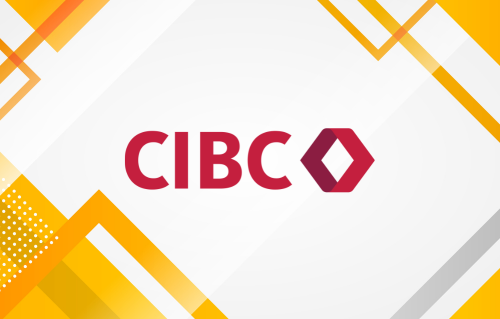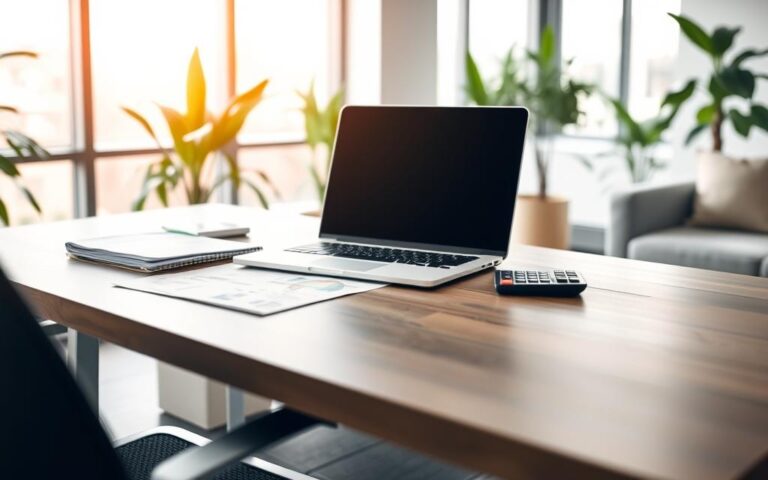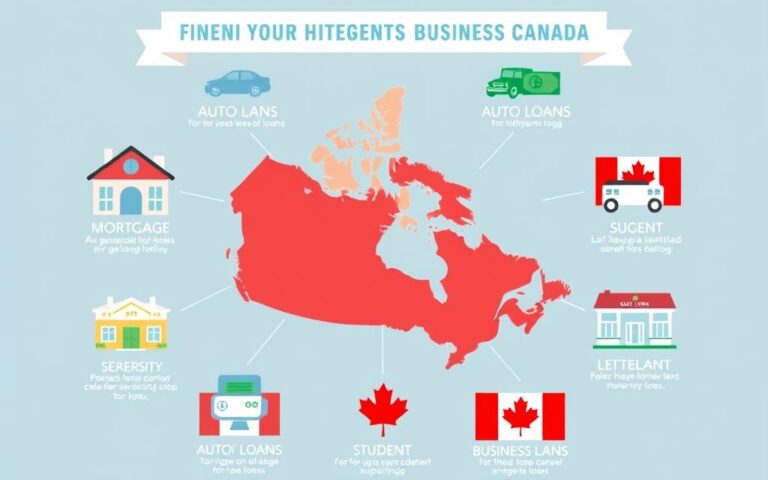adversiment
In 2023, Canadians held personal loans totaling $231 billion. This shows the growing need for personal financing. Finding the right bank for a loan is more important than ever.
This guide explores Canada’s top banks for personal loans in 2024. It aims to help you make smart choices about your finances.
We’ll cover the basics of personal loans and evaluate leading financial institutions. This information will help you find the best loan for your situation.
You might need a loan to pay off debt, make a big purchase, or get extra funds. Our guide will help you navigate Canada’s lending landscape effectively.
Top Banks for Personal Loans in Canada
Several top banks offer excellent personal loans in Canada. RBC, TD, BMO, and CIBC provide unique loan products to meet diverse borrower needs. Each bank has its own features and benefits for Canadian customers.
Royal Bank of Canada (RBC)
RBC is a leading bank for loans in Canada. They offer competitive rates and flexible repayment terms. Loan amounts range from $5,000 to $50,000 with fixed and variable-rate options.
RBC’s customer service is excellent. Their online application process is user-friendly, making it easy for borrowers to apply.
Royal Bank of Canada (RBC)
Click now to take the first step and find out how to request the loan.
Toronto-Dominion Bank (TD)
TD offers various personal loan solutions in Canada. These include debt consolidation, home improvement, and major purchase financing. Their loans have fixed interest rates and terms up to 5 years.
TD’s predictable monthly payments make them popular among Canadian borrowers. They’re a top choice for those seeking stability in loan repayment.
Toronto-Dominion Bank (TD)
Click now to take the first step and find out how to request the loan.
Bank of Montreal (BMO)
BMO provides a wide range of personal loan options in Canada. They offer unsecured personal loans and secured lines of credit. Their interest rates are competitive, with both fixed and variable-rate choices available.
BMO’s online tools make the application process easy. Their resources help customers navigate the loan process smoothly.
Bank of Montreal (BMO)
Click now to take the first step and find out how to request the loan.
Canadian Imperial Bank of Commerce (CIBC)
CIBC focuses on personalized service and customized loan solutions. They offer personal loans with fixed or variable rates. Loan amounts go up to $50,000 with repayment terms from 1 to 5 years.
CIBC’s loan offerings are tailored to meet unique financial needs. They aim to provide solutions that fit individual borrower requirements.
Canadian Imperial Bank of Commerce (CIBC)
Click now to take the first step and find out how to request the loan.
Compare features, interest rates, and terms from these top banks. This will help you find the best personal loan for your financial goals and budget.
Understanding Personal Loans in Canada
Personal loans are a popular financing option in Canada. They offer a flexible way for Canadians to borrow money. Banks and financial institutions provide these loans for various purposes.

What Are Personal Loans?
A personal loan is money borrowed from a lender, usually a bank or credit union. The borrower agrees to repay it over time, with interest. These loans can fund major purchases or help consolidate debt.
Common Uses for Personal Loans
- Financing home renovations or repairs
- Paying for medical expenses or emergencies
- Consolidating multiple debts, such as credit cards, into a single, manageable payment
- Covering the cost of a vacation or special event
- Funding a small business or personal project
How Personal Loans Work
To apply for a Canadian bank loan, you’ll need to provide income and credit history information. The lender will assess your creditworthiness and offer loan terms based on your risk profile.
Once approved, you’ll receive the loan amount and start making regular payments. These payments are typically monthly and continue until you’ve paid off the loan.
“Personal loans can be a valuable financial tool for Canadians, providing access to funds when needed and the flexibility to manage their finances effectively.”
Features to Consider When Choosing a Bank for Loans
Evaluating key features is vital when picking a bank for personal loans in Canada. These include Canadian bank loan rates, loan terms, and associated fees. Your choice can greatly affect borrowing costs and conditions.
Interest Rates
Bank loan interest rates Canada are a top priority when selecting a personal loan provider. Rates can differ widely between banks. It’s crucial to compare offers for the best deal.
Finding competitive rates can lead to significant savings over your loan’s lifespan. Take time to research and compare options thoroughly.
Loan Terms
Repayment periods and borrowing limits are important factors to consider. Longer terms may mean lower monthly payments. However, they can result in higher overall interest costs.
Choose a loan term that aligns with your financial situation. Consider both short-term affordability and long-term costs.
Fees and Charges
- Application fees: Some banks may charge a fee to process your loan application, so be sure to factor this into your overall cost comparison.
- Origination fees: These fees are often charged to cover the administrative costs associated with setting up your loan.
- Prepayment penalties: Understand if the bank charges any fees for paying off your loan early, as this can impact your ability to save on interest charges.
Carefully assess Canadian bank loan rates, terms, and fee structures. This will help you make an informed decision. Choose a bank that best suits your personal financial needs.
Personal loans require careful consideration of all details. Analyzing interest rates, terms, and fees is crucial. This approach helps find the most cost-effective solution for your financial situation.
How to Qualify for a Personal Loan
Canadian banks have specific eligibility criteria for personal loans. Knowing these requirements helps you prepare for loan approval. Let’s look at the key factors lenders consider.
Minimum Credit Score Requirements
Your credit score is crucial for Canadian banks. Most lenders prefer a score of 660 or higher. Some may accept lower scores, but with less favorable terms.
Improve your credit score by paying bills on time. Reducing your debt-to-credit ratio can also help. This increases your chances of getting a better loan rate.
Income Verification
Banks examine your income to ensure you can repay the loan. They require documents like pay stubs or tax returns. Lenders want to see steady employment and reliable income.
Debt-to-Income Ratio
Banks evaluate your debt-to-income (DTI) ratio. This compares monthly debt payments to gross monthly income. Lenders prefer a DTI ratio below 40%.
A low DTI ratio shows you can handle additional loan payments. It demonstrates your ability to manage debt responsibly.
Understanding these criteria helps improve your financial profile. This increases your chances of getting a loan from personal loan banks Canada or banks offering personal loans Canada.

Comparing Loan Offers from Different Banks
Shopping around is key to finding the best Canadian bank loan for your needs. Compare offers from multiple banks to secure favorable terms and rates. This helps you find the best bank for personal loan Canada.
Importance of Shopping Around
Loan terms and rates vary widely between Canadian banks. Exploring options helps you find the most competitive package. This simple step can save you money in the long run.
How to Evaluate Loan Terms
- Interest rate: Look for the lowest possible interest rate to minimize your total interest paid.
- Loan amount: Ensure the loan amount meets your financial requirements without overborrowing.
- Loan term: Consider the repayment period and how it fits your budget.
- Fees and charges: Be aware of any application fees, origination fees, or prepayment penalties.
Tools for Comparing Loans
Online tools and calculators can help you compare personal loan offers from different Canadian banks. These resources allow you to input key details for side-by-side comparisons. This helps you make an informed decision and find the best option.
| Bank | Interest Rate | Loan Amount | Loan Term | Fees |
|---|---|---|---|---|
| Royal Bank of Canada (RBC) | 7.99% | $20,000 | 3 years | $99 application fee |
| Toronto-Dominion Bank (TD) | 8.25% | $18,000 | 2 years | No fees |
| Bank of Montreal (BMO) | 7.75% | $25,000 | 4 years | $150 origination fee |
Carefully evaluate and compare personal loan offers from different Canadian banks. This helps you make an informed decision. You can secure the best bank for personal loan Canada to meet your financial needs.
The Application Process for Personal Loans
Personal loan applications can be simple with proper preparation. Understanding key steps helps you approach the process confidently. This guide covers bank personal loans in Canada and options from various lenders.
Step-by-Step Application Guide
- Determine your borrowing needs: Consider the amount you require and the purpose of the loan, such as debt consolidation, home renovation, or unexpected expenses.
- Check your credit score and history: Lenders typically assess your creditworthiness based on your credit score and payment history, so it’s essential to understand your financial standing.
- Gather the required documentation: This may include proof of income, identification, and information about your current debts and assets.
- Research and compare offers from different bank personal loans Canada providers: Compare interest rates, repayment terms, and any associated fees to find the best fit for your needs.
- Submit your loan application: You can typically apply for a personal loan banks Canada either online or in person at a branch.
- Wait for a decision: The lender will review your application and supporting documents, then provide a decision, typically within a few business days.
- Accept the loan offer and complete the process: If approved, you’ll need to sign the loan agreement and provide any additional information required.
Required Documentation
Documentation for personal loans can vary by lender. Typically, you’ll need proof of identity and income. You may also need to provide details about existing debts and assets.
- Proof of identity (e.g., driver’s license, passport)
- Proof of income (e.g., pay stubs, tax returns, employment letter)
- Information about your existing debts and assets
- Details about the purpose of the loan
Online vs. In-Branch Applications
You can apply for personal loans online or at a bank branch. Online applications are often faster and more convenient. In-branch visits offer personalized guidance from lending specialists.
Consider your preferences when choosing how to apply. Also, check the specific requirements of bank personal loans Canada providers.
Understanding Interest Rates and APR
Interest rates and Annual Percentage Rates (APR) greatly impact personal loan costs in Canada. Knowing their differences helps you make smarter borrowing decisions. Let’s explore how these factors affect your loan payments.
Fixed vs. Variable Interest Rates
Canadian personal loans offer fixed or variable interest rates. Fixed interest rates stay constant, ensuring predictable monthly payments. Variable interest rates can change over time, potentially altering your monthly dues.
Fixed rates provide stability, while variable rates may offer initial savings. Your choice depends on your financial situation and risk tolerance.
How APR Affects Loan Payments
APR represents the total yearly borrowing cost. It includes the interest rate and any additional loan fees. A higher APR means increased monthly payments and overall loan expenses.
When comparing loan offers, focus on the APR. It gives a more accurate picture of the loan’s true cost.
Tips for Securing Lower Interest Rates
- Maintain a good credit score: Lenders often offer lower bank loan interest rates Canada to borrowers with excellent credit histories.
- Shop around: Compare offers from multiple lenders to find the lowest interest rate personal loans Canada that fit your needs.
- Consider a shorter loan term: Loans with shorter repayment periods typically have lower interest rates.
- Explore options with your existing bank: Your current financial institution may be willing to offer a competitive rate to retain your business.
Understanding interest rates and APR helps you secure better loan terms. Compare offers carefully to find the best personal loan for your needs.
Remember, a lower interest rate can save you money over time. Take your time to research and choose wisely.
Alternative Lending Options in Canada
Traditional banks aren’t the only choice for personal loans in Canada. Alternative lenders offer more flexibility, competitive rates, and specialized services. Let’s explore three key options: credit unions, online lenders, and peer-to-peer lending platforms.
Credit Unions
Credit unions are member-owned financial cooperatives providing personalized lending experiences. They offer competitive best banks loans Canada with flexible terms. Credit unions focus on building relationships with members and understanding their unique financial needs.
Online Lenders
Financial technology has given rise to numerous online lenders in Canada. These digital platforms offer streamlined applications, fast approvals, and various personal loan banks Canada options. Online lenders appeal to tech-savvy borrowers who value digital lending experiences.
Peer-to-Peer Lending
Peer-to-peer (P2P) platforms connect borrowers with investors funding personal loans. This approach can offer competitive rates and personalized experiences. P2P lenders often have flexible ways to evaluate loan applications.
When exploring alternatives, compare interest rates, fees, loan terms, and application processes. This helps ensure you find the best fit for your financial needs.
By considering all personal loan choices in Canada, you can make an informed decision. This allows you to secure the funding you need.
Managing Your Personal Loan Responsibly
A Canadian bank loan can be a helpful financial tool. It’s crucial to manage your personal loan responsibly. Budgeting, understanding penalties, and using smart repayment strategies can help maintain financial stability.
Budgeting for Repayments
Create a realistic budget to manage your bank personal loans Canada effectively. Calculate your monthly income and expenses. Ensure that loan repayments fit comfortably within your budget.
This approach helps avoid missed payments and late fees. These issues can negatively impact your credit score.
Understanding Prepayment Penalties
Many Canadian bank loan providers may charge prepayment penalties. These apply if you pay off your loan early. Review your loan agreement carefully to understand potential early repayment fees.
This knowledge helps you make informed decisions. You’ll know the best time for additional payments or refinancing.
Strategies for Paying Off Loans Faster
- Make extra payments whenever possible: Even small, additional payments can significantly reduce the total interest paid and the overall repayment timeline.
- Increase your payment frequency: Consider switching to bi-weekly or weekly payments instead of monthly to accelerate the payoff process.
- Refinance your loan: If interest rates have decreased since you obtained your Canadian bank loan, refinancing may allow you to secure a lower rate and pay off the loan more quickly.
Responsible borrowing practices help manage bank personal loans Canada effectively. A disciplined approach to loan repayment supports healthy financial well-being.
Use these strategies to achieve your financial goals. Remember, smart loan management leads to better financial outcomes.
Current Trends in Canadian Personal Loans
The Canadian personal loan market is always changing. Many factors affect loan approvals, regulations, and availability. Staying informed helps Canadians make smart choices when looking for personal loans.
Trends Affecting Loan Approval Rates
Lenders have become more careful when approving personal loans. Credit score and income requirements are now stricter. This makes it harder for some people to get loans.
However, lenders are now looking at each person’s full financial picture. This means they consider more than just numbers when making decisions.
Changes in Lending Regulations
New rules protect consumers and encourage responsible lending. These include guidelines for loan-to-value ratios and debt-to-income thresholds. Lenders must also share more information with borrowers.
These changes aim to protect Canadians. But they may also affect who can get loans and on what terms.
The Impact of Economic Factors on Loans
Canada’s economy greatly influences the personal loan market. Interest rates, inflation, and unemployment can affect loan costs and availability. These factors also impact how risky lenders view borrowers.
As the economy changes, lenders may adjust their rules. This can affect the types of loans available to Canadians.
FAQ
What are the best banks for personal loans in Canada?
Top banks for personal loans in Canada include RBC, TD, BMO, and CIBC. These banks offer various loan options with competitive rates and flexible terms.
What are the common uses for personal loans in Canada?
Personal loans in Canada are often used for debt consolidation and home renovations. They also help with major purchases, medical expenses, and unexpected financial emergencies.
How do personal loans work in Canada?
Personal loans in Canada provide a lump sum upfront. Borrowers repay the loan, plus interest, over time through regular monthly payments.
What features should I consider when choosing a bank for a personal loan in Canada?
Key features to consider include interest rate, loan terms, and fees. It’s crucial to compare offers from multiple lenders to find the best deal.
What are the qualification requirements for personal loans in Canada?
Main requirements typically include a minimum credit score and stable income. Banks may also look at debt-to-income ratio, employment history, and collateral.
How can I compare personal loan offers from different banks in Canada?
Evaluate factors like interest rate, loan term, and monthly payments. Also, check for any associated fees or charges.
Online loan comparison tools can help you assess offers from various Canadian banks easily.
What is the application process for personal loans in Canada?
The process involves providing personal and financial information. You’ll need to submit required documents and apply online or in-person.
The lender will review your application and make a decision on the loan.
How do fixed and variable interest rates work for personal loans in Canada?
Fixed rates stay the same throughout the loan term. Variable rates can change based on market conditions.
Fixed rates offer predictable monthly payments. Variable rates may start lower but can fluctuate over time.
What are some alternative lending options for personal loans in Canada besides banks?
Canadians can explore credit unions, online lenders, and peer-to-peer lending platforms. These alternatives may offer different features, eligibility criteria, and application processes.
How can I manage my personal loan responsibly in Canada?
Create a budget that includes your monthly loan payments. Understand any prepayment penalties that may apply.
Develop strategies to pay off the loan faster, such as making extra payments when possible.







